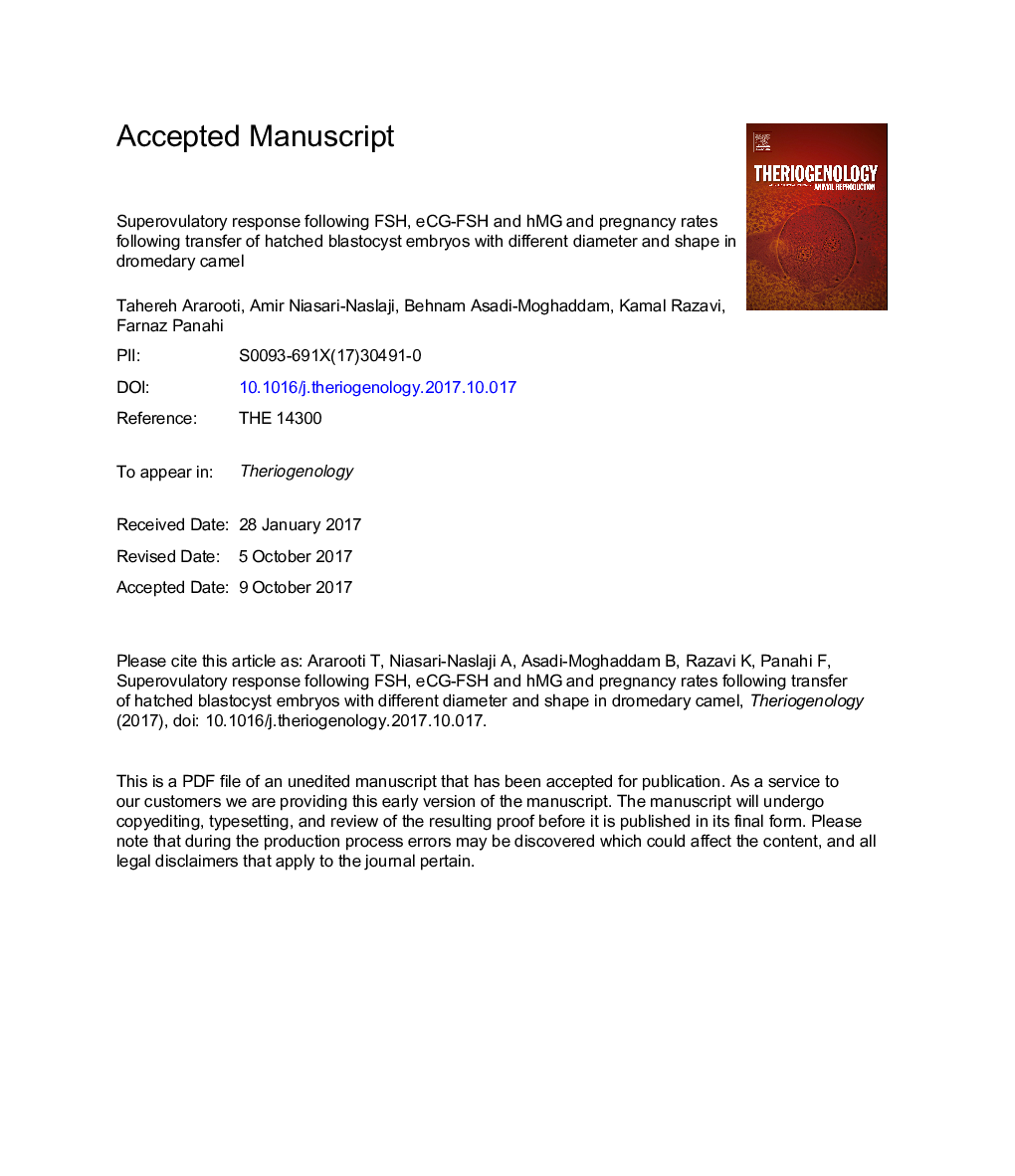| Article ID | Journal | Published Year | Pages | File Type |
|---|---|---|---|---|
| 8427823 | Theriogenology | 2018 | 32 Pages |
Abstract
The objectives of this study were to compare three superovulation protocols and to investigate the effect of embryo diameter and shape on pregnancy rates in dromedary camel. In Experiment 1, following follicular wave synchronization of donors using two injections of GnRH (25 μg, im), superovulation was initiated 2 days after the second GnRH (Day 0 of experiment). Then, donors were assigned into three groups (n = 5) and received 1) FSH alone (390 mg), 2) eCG (1000 IU; single dose on Day 0) and FSH (330 mg) and 3) hMG (17.5 ampules). FSH and hMG were administered twice daily, in decreasing doses, for 5.5 days. Thirty-six hours after the last dose of FSH or hMG, donors were mated once. On Day 4 of superovulation, the diameter and number of follicles and on Day 7.5 after mating, total number of corpora lutea and follicles â¥9 mm were recorded using ultrasound examination. On Day 8.5 after mating, embryos were recovered non-surgically. In Experiment 2, on Day 6.5 after inducing ovulation, recipients (n = 139) received a single 7.5 days old hatched blastocyst. The diameter and shape (round, oval, collapsed) of transferred embryos were recorded. Pregnancy was detected on Day 25 after embryo transfer. Data were analyzed using Proc GLM, Proc FREG, Proc CORR and Proc Genmod of SAS. The number of corpora lutea was greater in FSH (22.4 ± 2.25) than eCG-FSH (11.6 ± 2.58) and hMG (7 ± 3.19; P < 0.01). Total number of embryos was higher in FSH (16.2 ± 2.72) than hMG (1.6 ± 1.17; P < 0.01). In FSH group, there was correlation between the ratio of follicles >6 mm/follicles â¤6 mm on Day 4 of superovulation and total number of corpora lutea (r = 0.9; P < 0.05) and embryos (r = 0.91; P < 0.05). In the latter group, there was also correlation between corpora lutea and number of embryos (r = 0.92; P < 0.05). Transfer of embryos collected from different superovulation protocols did not affect pregnancy rates (P > 0.05). The diameter of hatched blastocysts had significant effect on pregnancy rates (P < 0.05). Medium size embryos (601-985 μm) produced greater pregnancy rates (50.8%) compared to small (275-600 μm; 25%) and large (986-1571 μm; 32%) embryos (P < 0.05). In conclusion, FSH protocol provided better and predictable superovulatory response. Greater pregnancy rates could be achieved by transferring medium size hatched blastocysts in dromedary camel.
Related Topics
Life Sciences
Agricultural and Biological Sciences
Animal Science and Zoology
Authors
Tahereh Ararooti, Amir Niasari-Naslaji, Behnam Asadi-Moghaddam, Kamal Razavi, Farnaz Panahi,
